Mechanical properties of pore-spanning lipid bilayers probed by atomic force microscopy
- PMID: 16617084
- PMCID: PMC1479081
- DOI: 10.1529/biophysj.106.081398
Mechanical properties of pore-spanning lipid bilayers probed by atomic force microscopy
Abstract
We measure the elastic response of a free-standing lipid membrane to a local indentation by using an atomic force microscope. Starting point is a planar gold-coated alumina substrate with a chemisorbed 3-mercaptopropionic acid monolayer displaying circular pores of very well defined and tunable size, over which bilayers composed of N,N,-dimethyl-N,N,-dioctadecylammonium bromide or 1,2-dioleoyl-3-trimethylammonium-propane chloride were spread. Centrally indenting these "nanodrums" with an atomic force microscope tip yields force-indentation curves, which we quantitatively analyze by solving the corresponding shape equations of continuum curvature elasticity. Since the measured response depends in a known way on the system geometry (pore size, tip radius) and on material parameters (bending modulus, lateral tension), this opens the possibility to monitor local elastic properties of lipid membranes in a well-controlled setting.
Figures
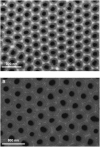

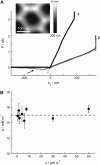
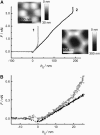


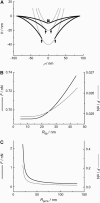


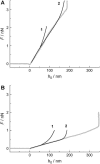
Similar articles
-
How to determine local elastic properties of lipid bilayer membranes from atomic-force-microscope measurements: a theoretical analysis.Phys Rev E Stat Nonlin Soft Matter Phys. 2006 Dec;74(6 Pt 1):061914. doi: 10.1103/PhysRevE.74.061914. Epub 2006 Dec 29. Phys Rev E Stat Nonlin Soft Matter Phys. 2006. PMID: 17280103
-
Local membrane mechanics of pore-spanning bilayers.J Am Chem Soc. 2009 May 27;131(20):7031-9. doi: 10.1021/ja809165h. J Am Chem Soc. 2009. PMID: 19453196
-
Computational analysis of adhesion force in the indentation of cells using atomic force microscopy.Phys Rev E Stat Nonlin Soft Matter Phys. 2008 Feb;77(2 Pt 1):021912. doi: 10.1103/PhysRevE.77.021912. Epub 2008 Feb 21. Phys Rev E Stat Nonlin Soft Matter Phys. 2008. PMID: 18352056
-
Mechanics of lipid bilayers: What do we learn from pore-spanning membranes?Biochim Biophys Acta. 2015 Nov;1853(11 Pt B):2977-83. doi: 10.1016/j.bbamcr.2015.05.029. Epub 2015 May 27. Biochim Biophys Acta. 2015. PMID: 26025679 Review.
-
Nanoscale mechanical properties of lipid bilayers and their relevance in biomembrane organization and function.Micron. 2012 Dec;43(12):1212-23. doi: 10.1016/j.micron.2012.03.013. Epub 2012 Mar 28. Micron. 2012. PMID: 22503400 Review.
Cited by
-
Structure and permeability of ion-channels by integrated AFM and waveguide TIRF microscopy.Sci Rep. 2014 Mar 21;4:4424. doi: 10.1038/srep04424. Sci Rep. 2014. PMID: 24651823 Free PMC article.
-
Spontaneous Curvature, Differential Stress, and Bending Modulus of Asymmetric Lipid Membranes.Biophys J. 2020 Feb 4;118(3):624-642. doi: 10.1016/j.bpj.2019.11.3398. Epub 2019 Dec 18. Biophys J. 2020. PMID: 31954503 Free PMC article.
-
Formation of lipid bilayer membrane in a poly(dimethylsiloxane) microchip integrated with a stacked polycarbonate membrane support and an on-site nanoinjector.Biomicrofluidics. 2015 Apr 22;9(2):024120. doi: 10.1063/1.4919066. eCollection 2015 Mar. Biomicrofluidics. 2015. PMID: 26015832 Free PMC article.
-
Implicit-solvent dissipative particle dynamics force field based on a four-to-one coarse-grained mapping scheme.PLoS One. 2018 May 24;13(5):e0198049. doi: 10.1371/journal.pone.0198049. eCollection 2018. PLoS One. 2018. PMID: 29795682 Free PMC article.
-
Viscoelasticity of basal plasma membranes and cortices derived from MDCK II cells.Biophys Rep (N Y). 2021 Sep 14;1(2):100024. doi: 10.1016/j.bpr.2021.100024. eCollection 2021 Dec 8. Biophys Rep (N Y). 2021. PMID: 36425463 Free PMC article.
References
-
- Alessandrini, A., and P. Facci. 2005. AFM: a versatile tool in biophysics. Meas. Sci. Technol. 16:R65–R92.
-
- Butt, H.-J., B. Cappella, and M. Kappl. 2005. Force measurements with the atomic force microscope: Technique, interpretation and applications. Surf. Sci. Rep. 59:1–152.
-
- Janshoff, A., M. Neitzert, Y. Oberdörfer, and H. Fuchs. 2000. Force spectroscopy of molecular systems - single molecule spectroscopy of polymers and biomolecules. Angew. Chem. Int. Ed. Engl. 39:3346–3374. - PubMed
-
- Janshoff, A., and C. Steinem. 2001. Scanning force microscopy of artificial membranes. ChemBioChem. 2:798–808. - PubMed
-
- Boal, D. 2002. Mechanics of the Cell. Cambridge University Press, Cambridge.
Publication types
MeSH terms
Substances
LinkOut - more resources
Full Text Sources

